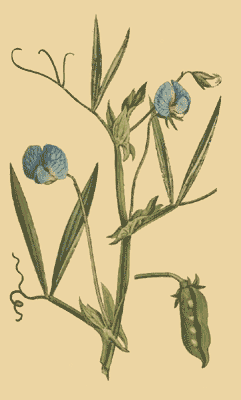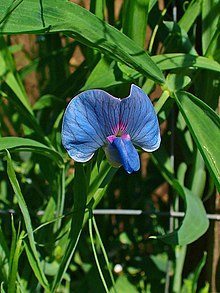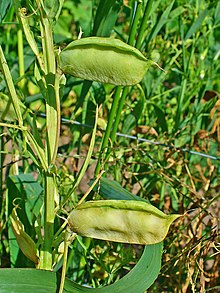Common pea
| Common pea | ||||||||||||
|---|---|---|---|---|---|---|---|---|---|---|---|---|

Common pea ( Lathyrus sativus ), illustration |
||||||||||||
| Systematics | ||||||||||||
|
||||||||||||
| Scientific name | ||||||||||||
| Lathyrus sativus | ||||||||||||
| L. |
The Lathyrus sativus ( Lathyrus sativus ) is a plant species within the family of legumes (Fabaceae). Flat peas are used as fodder, but flour made from the legumes of this plant is also used for food in some regions. Wild occurrences of this ancient cultivated plant are not known.
description
Vegetative characteristics
The flat pea is an annual plant with strong roots . Their stems are prostrate or climbing and are 15 to 60, rarely 100 cm long. They are heavily branched, have 0.5 to 1.5 mm wide wings and are 4 to 6 mm wide with these. The leaf stalks are also broadly winged (1 to 2.5 mm). All leaves have a pair of plumage, the upper leaves simple or more often branched tendrils . The leaflets are 2.5 to 15 cm long, 3 to 7 mm wide, and at least 3 times as long as they are wide. Their shape is linear-lanceolate to elliptical, they have 5 to 7 distinct and several thin longitudinal nerves. The stipules are 10 to 20 mm long and 2 to 5 mm wide and lanceolate to semi-arrow-shaped.
Generative characteristics
The short-stalked flowers are usually individually in reduced, racemose inflorescences. The inflorescence stem is 3 to 6 cm long, towers above the petiole and ends in a short awn. The bract is flaky.
The hermaphrodite flowers are zygomorphic and five-fold with a double flower envelope . The cup is bare. The calyx teeth are lanceolate, almost as long as one another and two to three times as long as the short calyx tube. The crown is 12 to 24 mm long and of different colors: mostly it is white with bluish veins, more rarely pink or bluish. The wings, shuttle and stylus are turned to the left, which makes the flower very asymmetrical.
The legume is mm and a length of 25 to 40 of a width of 10 to 18 mm ovate to rhombic, flat, bare and network annoying. Its color is straw-colored, it has a double-winged seam and contains two to five seeds . The seeds are 7 to 10 (rarely 15) mm long, 5 to 9 mm wide and 4 to 6 mm high, are angular and have the shape of an ax. The seed coat is smooth and differently colored, often with brown spots. The navel is elliptical, 1.5 to 2 mm long.
The number of chromosomes is 2n = 14.
Flower ecology
From an ecological point of view, these are butterfly flowers with a brush mechanism. Self-pollination predominates . Cross-pollination only takes place if a suitable flower visitor sits in the middle of the flower. Due to the rotation of the shuttle, flower visitors can suck nectar on the right side .
Occurrence
The home of the flat pea is probably in the Mediterranean area and in the Middle East. Wild occurrences are not known. It is an old cultivated plant and naturalized far beyond its original range. In southern Europe it has been cultivated since ancient times, north of the Alps it has only been documented since the 16th century.
It grows preferentially on fresh, nutrient-rich and lime-rich clay soils and is restricted to the colline altitude .
use
In Central Europe , the flat pea is only rarely grown as a forage plant (green or as a grain forage plant ). It has found some distribution again as a green manure plant. As a grain crop with maximum yields of 2 to 3 tons per hectare, it is not competitive in Europe. The flat pea with several cultivated varieties is only of some importance in India.
Common peas also play a small role in human nutrition. The European countries in which the flour made from legumes is eaten include Spain and Italy. It is also used as a food in Africa and Asia.
Toxicity
The seeds in particular are poisonous. The main active ingredients are 1.5–2.5% allantoin , around 1.74% arbutin and the neurotoxin β- (N-γ-glutamyl) aminopropionitrile .
Poisoning, the so-called lathyrism , with cultivated Lathyrus species used to occur frequently in horses and cattle. Symptoms in horses are laryngeal whistling , nervousness , excitement, spinal paralysis, especially of the hind limbs. These phenomena are particularly evident in moving animals, while resting animals make a healthy impression. The disease progresses over several days and weeks. Skeletal changes were found in cattle.
Lathyrism also occurs in humans when, in times of need, they feed mainly on the flour of the drought-resistant flat peas. Clinically, lathyrism neurotoxicity manifests itself in muscle spasms, cramps of the limb muscles and progressive spastic paralysis ( paresis ) of the leg muscles. The walk in which the affected person actually falls from one leg to the other is typical. Sensory and bladder dysfunction can also occur. Occasionally, gross tremor of the arms is observed.
A devastating outbreak of this disease at the beginning of the 19th century has been described for Europe. Many Spaniards ate flat peas to a large extent during the wars of liberation against Napoleon . Francisco Goya recorded the consequences of this disease in his etching Gracias a la Almorta (“Thanks to the flat pea ”). Lathyrism still occurs today in drought areas when other foods are scarce. Outbreaks in the recent past have been described for China, India, Bangladesh and Ethiopia, among others.
swell
- Siegmund Seybold (Ed.): Schmeil-Fitschen interactive . CD-ROM, version 1.1. Quelle & Meyer, Wiebelsheim 2002, ISBN 3-494-01327-6 .
Individual evidence
- ↑ a b c Species description from the University of Gießen , accessed on August 1, 2008.
- ^ Manfred A. Fischer, Karl Oswald, Wolfgang Adler: Excursion flora for Austria, Liechtenstein and South Tyrol . 3rd, improved edition. State of Upper Austria, Biology Center of the Upper Austrian State Museums, Linz 2008, ISBN 978-3-85474-187-9 .
- ↑ a b c d e Lutz Roth, Max Daunderer, Kurt Kormann: Toxic Plants - Plant Poisons. Occurrence, effect, therapy, allergic and phototoxic reactions. With a special section about poisonous animals. 6th, revised edition, special edition. Nikol, Hamburg 2012, ISBN 978-3-86820-009-6 .
- ↑ Amy Stewart: Common Plants . Berliner Taschenbuch Verlag, Berlin 2010, ISBN 978-3-8270-7441-6 , p. 62
Web links
- Common pea. In: FloraWeb.de.
- Distribution map for Germany. In: Floraweb .
- Lathyrus sativus L. In: Info Flora , the national data and information center for Swiss flora . Retrieved November 27, 2015.
- Thomas Meyer: Data sheet with identification key and photos at Flora-de: Flora von Deutschland (old name of the website: Flowers in Swabia )



